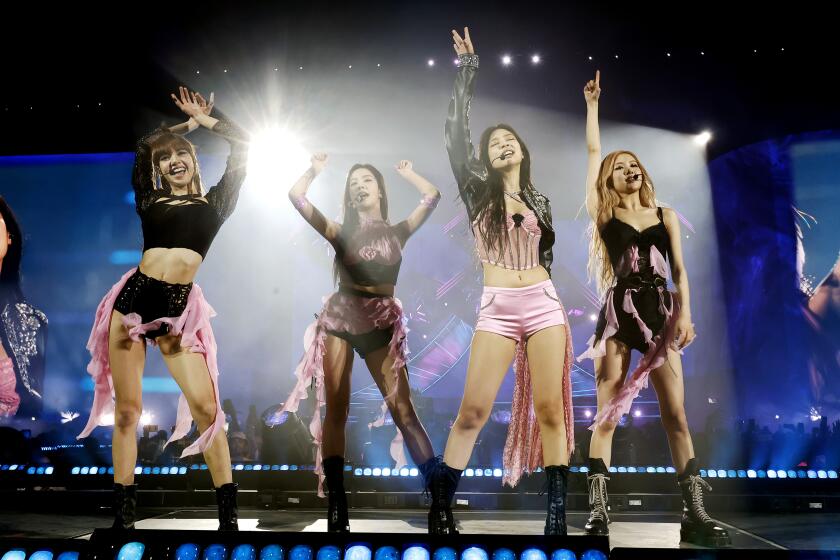Something in the Air
- Share via
The first hint of the sea change might have been the swampy trip-hop mix that followed you from the concierge desk to the elevator, its groove as alluring as the textured wallpaper and the potted pampas grass in the hotel entryway. Or perhaps it was the ghostly nouvelle Django Reinhardt guitar that segued into some Algerian Rai music at that new neighborhood bistro.
Interesting mix tapes?
Not quite.
In the old days, canned background music was thought of as distracting, nerve-racking, schlocky--but seldom hip. Now, the sonic mixes or ethereal loops of found-sounds that turn your gym’s locker room or your favorite shoe store into an after-hours club resonate like the work of a DJ building a late-night mix, though they’ve no doubt been created by a new breed of designers who dub themselves audio architects. Their goal is to trigger, or recall, a palette of emotions, to create an overall “vibe” for a business, product or individual.
So background music isn’t simply a playlist; it’s what is known as a sound-print or, better yet, a sonic analogy to a business itself, an emotional imprint to be linked closely with that company or experience. Songs, beats and moods are used the same way as logos are, as tools for branding.
The enterprises that offer “sound styling” or “foreground music”--with staff drawn from the ranks of record store clerks, film industry folk and musicians--are being hired to style music for fast-food outposts, boutique hotels and government agencies. Even Muzak Corp., the originator of “piped-in” background music, has reinvented itself.
“We’re selling emotion,” says Alvin Collis, head of strategy and branding. “A brand is an emotional composition. We ask our clients a lot of questions about their business: We want to know who you are, how you market yourself, what kind of stories you tell. What is your internal culture? What are your aspirations? What do you want to be?”
The idea is to get into the skin of a business in order toget under the skin of a patron or customer. “As a commercial supplier, we develop concepts that are demographically, psychographically and environmentally reflective, so they can be programmed for what’s going on in the environment or the people who are in it,” says Michael Malone, founder of AEI Music Network and retired chairman of DMX Music, the company that pioneered the notion of foreground music in the 1970s.
This is not about collecting a bunch of “cool songs,” says Collis at Muzak, whose clients include Red Lobster, BCBG and the U.S. Postal Service. “While a graphic artist designs a visual image--a trademark--what they are really designing is an experience. An architect creates a brand in three dimensions. With music, it is something that you can’t touch, you can’t taste. It’s about building an experience out of emotion.”
To that end, stylists have been dreaming up sui generis washes of music, voice or sound, sophisticated playlists that, they hope, telegraph confidence, diversity or timelessness in the voice of a jazz chanteuse or the simple brush of a snare drum. What, then, does eyeglass maker Lenscrafters sound like? A sampling of India.Arie, John Mayer and Tony Bennett that, according to Muzak’s website, telegraphs “integrity and authenticity.”
Tom Schnabel, host of KCRW’s genre-trotting radio show “Cafe L.A.,” says that what audio architects are doing is “creating a playlist for your life. A soundtrack. It’s a lifestyle project. And why not?”
The cost varies; a standard Muzak package could cost $65 a month, while New York-based Activaire charges a monthy fee of $100 to $150 for no-frills service.
Activaire is one of the newer faces of audio architecture. Its focus is on carving a niche in layering ambient mixes for high-end boutiques, office building lobbies, cafes, spas and hotels. With a staff of six that includes musicians, sound engineers, architects and DJs, the company’s client list has grown to include not only small hotels but also the Hyatt chain.
Activaire’s co-founding chief executive and music stylist, Lara Wiesenthal, is immersed in the part intuition/part sociology art of designing sound. Sound, Wiesenthal explains, is just as important to setting a mood as interior design--the play of light, the plush of the carpet. “It’s really about wanting to create that link, thinking a little bit about music and sound and light. And how they all fit.”
Though she has a degree in architecture from Pratt Institute, Wiesenthal always had an ear for music and how beats, moods and rhythms dovetail with each other and create their own structure. “My family was completely horrified with the mix-tape activity,” she recalls. “When people asked me what I do, I’d say ‘I play the stereo.’ ”
That interest has evolved into what Wiesenthal and her partners--her husband, Adesh Deosaran, president of technology and design, and Leonard Stewart, who heads licensing and legal services--do today. “It’s truly about design and placing and the order of things. But it’s been tough, because the idea is really abstract. It’s like graphic design, but with audio.”
For businesses, the process of audio design begins with what’s called a Lifestyle Audit to help the team assess the clients, how they see themselves and their goals. “Do they want to make people shop? Do they want to make people linger,” asks Wiensenthal. “Or, say, for a dentist’s office, you’d want an extremely calm mix that just numbs something in their brains, to ebb them into relaxation.”
What’s factored in next are elements such as architecture (Is the space modern glass and steel? Is it older? Wood or brick? High ceilings or low? Airy passageways?); demographics (Who visits the space? Women? Ages? Occupations?); and location (Is it downtown or uptown? Industrial or upscale/trendy? Is it in a gentrifying neighborhood or one that is old guard? Are the common areas busy or “chill”?). Then the designers go to work honing a playlist that not only will brand the company or business but also reflect its many moods.
There isn’t a fixed template, Wiesenthal explains. At the Hotel Victor on Miami’s South Beach, for example, the common areas--from lobby to bar to pool--are done up in Latin and African rhythms to great effect, says the person who should know best, the hotel’s vibe manager, Victoria Prado. “You second glance it. Because it is not familiar. It’s mysterious and eclectic.”
Sound styling is a meticulous process, full of trial and error, explains Wiesenthal, who agreed to hook up with a local business, Edendale Grill in Silver Lake, to illustrate the process. Wiesenthal would design a playlist that would help Edendale create a resonant sound stamp; the grill’s owners, Patti Peck and Melanie Tusquellas, figured that the process might help them solve some of their music issues (for example, there was the problem with songs played over and over, day after day, like stuttering CDs).
First, Tusquellas sent Wiesenthal information about the restaurant--blueprints, photos, menus, equipment specs--and Wiesenthal began to identify the challenges of designing a music menu for this watering hole.
The bar and restaurant occupy two different structures, a 1920s firehouse and a garage for the engines. Different sorts of people frequent the bar and restaurant at the same time, with an older crowd and families eating and a younger, often single, crowd drinking. There were indoor/outdoor spaces to consider, and the location itself, in a historic district in the heart of a community that prides itself being several steps ahead.
“Our clientele is 18 to 60, very hip, eclectic,” says Tusquellas. “Many of them are in the arts and entertainment industry. There are also a lot of families. We knew we couldn’t have two different sound systems and two different kinds of music, since they’d compete with each other.” They had been making do with CD mixes that include artists from ABBA to Frank Sinatra, with some indie rock and jazz thrown in.
There was a lot to think about and integrate, says Wiesenthal, who began shooting e-mails to Tusquellas with her impressions: “Your clay roof tiles lead to vibrant country western embroidery--it came to me in a flash.” “The country western images from the ‘50s struck a chord, because of the history that Edendale shares with the picture industry. The color and style of those images remind me of the Edendale logo.”
“Our initial impressions about Edendale were based on rumors about Silver Lake,” says Wiesenthal. “We were told that it was an indie-rock-hipster neighborhood similar to Williamsburg, Brooklyn.”
For a long-distance assessment, Tusquellas thought Wiesenthal’s initial read was dead-on. She understood the important intersection of a historic neighborhood’s past and present with a clientele that is both older and younger--and confidently au courant and thus difficult to impress.
Wiesenthal then started dreaming up idiosyncratic mixes that might merge, for example, country and hip-hop. It was a way to acknowledge silent movie shoot-’em-ups and the present-day urban soundtrack of hip- hop.
“We [didn’t’] have a lot of country in the library just yet,” says Wiesenthal. “So we needed to bone up.”
To start, says Wiesenthal, “it was the Izzys, sort of funky, bluesy, country rockabilly, and a band called the Dreamers, who are reminiscent of the Smiths, who really nailed what I was trying to go for with this first playlist.”
After more back and forth about the restaurant’s existing sound system and compatibility, Wiesenthal shipped off the first iPod. “The playlist ranged from harsh electronic, including Aphex Twin, to lighter electronica by Ulrich Schnauss,” she recalls. “We added in a mix of rock and indie pop from Bettie Serveert to Club 8 ... . It was just a really insane mix. Just too many genres.”
As Tusquellas says, “It was too high-paced and it made people jittery during the dinner hour. It made the staff crabby. It worked better for 11 to 1 a.m. So I usually didn’t turn it on until 10.”
She shipped the mix back and voiced her concerns. “We needed more songs, more jazz. There wasn’t enough Frank Sinatra.” Wiesenthal went back to work. She loaded 350 tracks culled from their vast library. “At this point, I had had a really good, long meditation about the place. I thought about the architecture, menu location, the history of Silver Lake. The key for me was the storybook illustration [of the firehouse] from the menu. I had a ‘Eureka!’ moment. The Spanish tiles reminded me of lace trim [and it hit me] that there was something innately feminine about the Edendale Grill.
“The second playlist was definitely deeper and more soulful than the first. The music is organized into several playlists, and every playlist shuffles. Edendale can choose their playlists from the iPod to suit their mood.”
Tusquellas was impressed. “Music is so important. It fills in the dead spaces.” She still is collecting feedback from customers. “People are noticing the songs, the newness of the songs. They’ll say, ‘Oh, you’re really current with your music’ or ‘That’s something that I heard in a club in New York.’ ”
Wiesenthal says she’s just hitting her stride. A face-to-face meeting with Tusquellas, who was in New York on business, offered more clarity. “She’s a vibrant, energetic, sexy woman, so the music should reflect this,” says Wiesenthal. “Edendale has a heady, delicious multilayered ambience. We’re pulling soul, disco, soulful country and psychedelic rock for their next playlist, including artists Amos Lee and Bright Eyes. We want the music to really resonate within Edendale.”
“It’s like the dude in the beautiful car, but the music is horrible. You see him coming in this gorgeous Jag, but oh no! He’s blasting this horrible trance!”
More to Read
The biggest entertainment stories
Get our big stories about Hollywood, film, television, music, arts, culture and more right in your inbox as soon as they publish.
You may occasionally receive promotional content from the Los Angeles Times.










